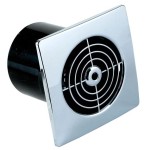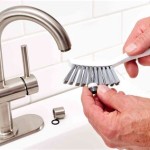Is A Bathroom Vent Necessary?
The presence of a bathroom vent, or exhaust fan, is a common feature in modern homes and commercial buildings. Its primary function is to remove excess moisture and odors from the bathroom environment. However, the question of whether a bathroom vent is truly necessary is a valid inquiry that requires a thorough examination of its benefits and potential consequences of its absence.
Bathrooms, by their very nature, are spaces subjected to significant fluctuations in humidity and temperature. Activities such as showering, bathing, and even using the sink contribute to a rapid increase in moisture levels. This elevated humidity, if left unaddressed, can create a breeding ground for mold and mildew, potentially leading to structural damage and health problems. Furthermore, the accumulation of odors from toilet use and personal hygiene products can negatively impact the overall air quality within the bathroom and, potentially, the surrounding areas of the building.
Regulations and building codes often mandate the installation of bathroom vents, particularly in new construction. These mandates are typically based on considerations of health, safety, and building longevity. While the specific requirements may vary depending on local jurisdictions and building design, the underlying principle remains consistent: to mitigate the risks associated with excessive moisture and poor air quality.
Mitigation of Moisture and Mold Growth
The elimination of excess moisture is arguably the most critical function of a bathroom vent. When hot water is used for showering or bathing, the resulting steam significantly increases the humidity level within the bathroom. This moisture can condense on surfaces such as walls, ceilings, windows, and mirrors, creating an ideal environment for mold and mildew to thrive. Prolonged exposure to these microorganisms can lead to a range of problems, including discoloration of surfaces, unpleasant odors, and, more seriously, structural damage to the building materials.
Mold and mildew can feed on organic materials commonly found in bathrooms, such as drywall, wood framing, and even soap scum. As they grow, they can weaken these materials, potentially compromising the structural integrity of the bathroom. Furthermore, mold and mildew spores can become airborne, circulating throughout the building and potentially triggering allergic reactions or respiratory problems in occupants, especially those with pre-existing sensitivities or conditions such as asthma. A properly functioning bathroom vent effectively removes this moisture-laden air, reducing the likelihood of condensation and inhibiting the growth of mold and mildew. The vent achieves this by drawing the humid air out of the bathroom and exhausting it to the exterior of the building. This process helps to maintain a drier environment and prevents the accumulation of moisture that facilitates the growth of these harmful microorganisms.
The effectiveness of a bathroom vent in mitigating moisture depends on several factors, including the size of the bathroom, the frequency and duration of showers and baths, and the ventilation rate of the fan. A larger bathroom or more frequent use will necessitate a more powerful fan with a higher ventilation rate, measured in cubic feet per minute (CFM). It is also important to ensure that the vent is properly installed and maintained to ensure optimal performance. Regular cleaning of the fan and ductwork is necessary to remove dust and debris that can impede airflow and reduce its effectiveness.
Odor Removal and Air Quality Improvement
In addition to moisture control, bathroom vents play a crucial role in removing unpleasant odors and improving the overall air quality within the bathroom. Bathrooms are often exposed to a variety of potentially offensive odors arising from toilet use, personal hygiene products, and cleaning supplies. These odors can linger in the air, creating an unpleasant and potentially unhealthy environment. A bathroom vent effectively removes these odors by drawing them out of the bathroom and exhausting them to the exterior of the building, preventing them from permeating the surrounding areas.
The removal of odors is not merely a matter of aesthetics; it can also have a significant impact on the health and well-being of occupants. Some odors, such as those from certain cleaning products, can be irritating to the respiratory system or even trigger allergic reactions in sensitive individuals. By removing these odors, a bathroom vent contributes to a healthier and more comfortable indoor environment. Furthermore, improved air quality can enhance the overall perception of cleanliness and hygiene, creating a more pleasant and inviting space.
The effectiveness of a bathroom vent in odor removal depends on factors such as the ventilation rate of the fan and the source of the odors. A more powerful fan with a higher ventilation rate will be more effective at quickly removing odors from the bathroom. It is also important to identify and address the source of any persistent or offensive odors. This may involve using odor-neutralizing products, improving ventilation in other areas of the bathroom, or addressing any underlying plumbing issues that may be contributing to the problem.
Prevention of Structural Damage
The detrimental effects of excessive moisture on building materials extend beyond the growth of mold and mildew. Prolonged exposure to moisture can lead to a range of structural problems, including warping, rotting, and corrosion of various building components. These problems can be costly to repair and can compromise the structural integrity of the bathroom and the surrounding areas.
Drywall, a common material used for bathroom walls and ceilings, is particularly susceptible to damage from moisture. When drywall becomes saturated with moisture, it can swell, warp, and even crumble. This can lead to unsightly cracks, peeling paint, and ultimately, the need for costly repairs. Wood framing, another common building material, is also vulnerable to moisture damage. Wood that is repeatedly exposed to moisture can rot, weaken, and become infested with insects such as termites. This can compromise the structural integrity of the bathroom and potentially lead to more extensive damage to the building.
Metal components, such as plumbing pipes and fixtures, can also be affected by moisture. Prolonged exposure to moisture can cause corrosion, which can weaken the metal and eventually lead to leaks or failures. These leaks can cause further water damage and can create a breeding ground for mold and mildew. A bathroom vent helps to prevent structural damage by removing excess moisture from the bathroom environment, protecting these building materials from the damaging effects of water. By maintaining a drier environment, the vent helps to prolong the lifespan of the bathroom's structural components and reduce the risk of costly repairs.
While natural ventilation, such as opening a window, can provide some relief from moisture buildup, it is often inadequate, especially during periods of inclement weather or in bathrooms that lack windows. Furthermore, natural ventilation may not be sufficient to remove odors effectively, particularly in bathrooms with high usage or limited air circulation. A properly installed and functioning bathroom vent provides a reliable and consistent means of removing moisture and odors, regardless of the weather conditions or the availability of natural ventilation. This is particularly important in climates with high humidity or in buildings with poor overall ventilation.
In conclusion, the presence of a bathroom vent offers several significant benefits related to moisture control, odor removal, and the prevention of structural damage. The absence of a vent can lead to a cascade of problems, including mold and mildew growth, poor air quality, and deterioration of building materials. Therefore, the installation and proper maintenance of a bathroom vent are highly recommended, and often mandated, to ensure a healthy, safe, and structurally sound bathroom environment.

Effective Ventilation

Bathroom Ventilation 9 Easy Ways To Improve Bob Vila

How To Vent A Bathroom With No Outside Access

Does Your Bathroom Need An Exhaust Fan Mr Rooter

Can A Bathroom Fan Vent Into The Attic Code Explained Building Trainer

Toilet Bathroom Exhaust Fan Why It Is Important

5 Things You Need To Know Before Getting A Bathroom Exhaust Fan Lifestyle News Asiaone

Bathroom Ventilation

Your Complete Guide To Bathroom Ventilation Victoriaplum Com

Bathroom Exhaust Fans Types Uses Benefits And More
Related Posts







